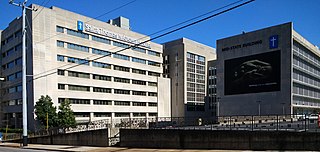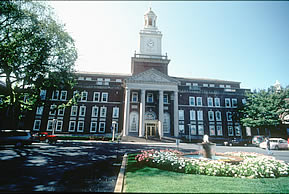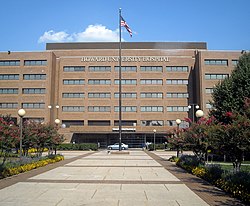
Medicine is the science and practice of caring for patients, managing the diagnosis, prognosis, prevention, treatment, palliation of their injury or disease, and promoting their health. Medicine encompasses a variety of health care practices evolved to maintain and restore health by the prevention and treatment of illness. Contemporary medicine applies biomedical sciences, biomedical research, genetics, and medical technology to diagnose, treat, and prevent injury and disease, typically through pharmaceuticals or surgery, but also through therapies as diverse as psychotherapy, external splints and traction, medical devices, biologics, and ionizing radiation, amongst others.
A trauma center, or trauma centre, is a hospital equipped and staffed to provide care for patients suffering from major traumatic injuries such as falls, motor vehicle collisions, or gunshot wounds. A trauma center may also refer to an emergency department without the presence of specialized services to care for victims of major trauma.

Stanford University Medical Center is a teaching hospital which includes Stanford Health Care and Stanford Children's Health. It serves as a private hospital for the Stanford University School of Medicine. In 2022–23, it was ranked by the US News as the 3rd-best hospital in California and 10th-best in the country.
The NewYork-Presbyterian Hospital, a nonprofit academic medical center in New York City, is the primary teaching hospital for two Ivy League medical schools, Weill Cornell Medicine at Cornell University and Columbia University Vagelos College of Physicians and Surgeons at Columbia University. The hospital includes seven campuses located throughout the New York metropolitan area. The hospital's two flagship medical centers, Columbia University Irving Medical Center and Weill Cornell Medical Center, are located on opposite sides of Upper Manhattan.
The John Hunter Hospital and John Hunter Children's Hospital is a teaching hospital and children's hospital in Newcastle, and northern New South Wales, Australia. The 820 bed hospital is the main teaching hospital of the University of Newcastle. The hospital contains the only trauma centre in New South Wales outside the Sydney Metropolitan Area, and has the busiest emergency department in the state. John Hunter is the busiest trauma hospital in the country.
Bronson Methodist Hospital is a 434-bed non-profit teaching hospital located in downtown Kalamazoo, Michigan, United States, and is a Level I trauma center. Bronson Methodist Hospital is the flagship of the Bronson Healthcare Group, a non-profit healthcare system serving all of southwest Michigan and northern Indiana. Bronson Methodist Hospital provides care in cardiology, orthopedics, surgery, emergency medicine, neurology, oncology; in neurological care as a Comprehensive Stroke Center; in cardiac care as a Chest Pain Center; in obstetrics as a BirthPlace and high-risk pregnancy center, and in pediatrics as a children's hospital.

Adventist HealthCare Shady Grove Medical Center is a 266-licensed bed acute care facility located in Rockville, Maryland. Shady Grove Medical Center provides a range of health services to the community such as high-risk obstetrical care, cardiac and vascular care, oncology services, orthopedic care, surgical services and pediatric care. Opened in 1979 as Shady Grove Adventist Hospital, Shady Grove Medical Center operates as part of Adventist HealthCare, a health-care delivery system that includes hospitals, home health agencies and other health-care services. Adventist HealthCare is headquartered in Gaithersburg, Maryland.

Arrowhead Regional Medical Center (ARMC) is a teaching hospital located in Colton, California, within Southern California's Inland Empire. ARMC is owned and operated by the County of San Bernardino. The emergency department (ED) at ARMC is the second busiest ED in the state of California. The hospital operates ten different residency training programs.

University of Missouri Health Care is an American academic health system located in Columbia, Missouri. It's owned by the University of Missouri System. University of Missouri Health System includes five hospitals: University Hospital, Ellis Fischel Cancer Center, Missouri Orthopedic Institute and University of Missouri Women's and Children's Hospital — all of which are located in Columbia. It's affiliated with Capital Region Medical Center in Jefferson City, Missouri. It also includes more than 60 primary and specialty-care clinics and the University Physicians medical group.
Spartanburg Regional Healthcare System(SRHS) is one of South Carolina's largest healthcare systems. SRHS draws patients primarily from the areas of Spartanburg, Cherokee, Union, and Greenville counties (all located in the Piedmont region of South Carolina), as well as Rutherford and Polk counties (located in western North Carolina). Spartanburg General Hospital was organized under the authority of the South Carolina General Assembly in 1917. It officially became the Spartanburg Regional Health Services District, Inc., a political subdivision of the State of South Carolina, by the charter granted by the Secretary of State of South Carolina on May 1, 1995.
MedStar Health is a not-for-profit healthcare organization. It operates more than 120 entities, including ten hospitals in the Baltimore–Washington metropolitan area of the United States. In 2011 it was ranked as the private sector employer with the largest number of local employees in the region.
St. Cloud Hospital is a hospital in St. Cloud, Minnesota, United States. It is a Catholic-affiliated, not-for-profit institution and part of CentraCare Health. The hospital has more than 9,000 employees, 400 physicians and 1,200 volunteers. It serves 690,000 people in a 12-county area.

University of Iowa Stead Family Children's Hospital formerly University of Iowa Children's Hospital and Children's Hospital of Iowa is a pediatric acute care academic children's hospital located in Iowa City, Iowa. The hospital was founded in 1919 and its current facility, opened in 2017, overlooks the university's football home, Kinnick Stadium. The hospital has 190 inpatient pediatric beds and is affiliated with the University of Iowa Carver College of Medicine. The hospital provides comprehensive pediatric specialties and subspecialties to pediatric patients aged 0–21 throughout Iowa and is one of the only children's hospitals in the region and state. University of Iowa Stead Family Children's Hospital also features the only ACS verified Level 1 Pediatric Trauma Center in the state.

Ascension Saint Thomas Hospital Midtown, formerly known as Baptist Hospital, is a non-profit community hospital in Nashville, Tennessee, United States and the largest such hospital in Middle Tennessee. It is licensed for 683 acute and rehab care beds.

Grinnell Regional Medical Center (GRMC) is an American private, nonprofit and non-tax supported 49-bed rural community hospital in Grinnell, Iowa. With 50 physicians and allied healthcare professionals, 400 employees, and more than 300 volunteers, it serves an estimated 47,000 residents in east-central Iowa in the counties of Poweshiek, Jasper, Benton, Iowa, Mahaska, and Tama. GRMC is located at 210 Fourth Avenue in Grinnell.

Monroe Carell Jr. Children's Hospital at Vanderbilt, also known as Children's Hospital at Vanderbilt, is a nationally ranked pediatric acute care children's teaching hospital and entity of Vanderbilt University Medical Center in Nashville, Tennessee. The hospital is affiliated with Vanderbilt University School of Medicine's Department of Pediatrics.

Adventist HealthCare White Oak Medical Center is a hospital with 180 private patient rooms and serves patients in Montgomery, Prince George's, and surrounding counties.
The New Freedmen's Clinic is a free student-run health care clinic affiliated with Howard University Hospital (HUH) and Howard University College of Medicine (HUCM). It gets its name from HUH's original name - Freedmen's Hospital. It is currently located in the heart of Washington, DC, within HUH.

Reading Hospital is a 697-bed non-profit teaching hospital located in West Reading, Pennsylvania. The hospital was established in 1867 and is the anchor institution of Tower Health.
Clive O. Callender is an American surgeon and professor of surgery at Howard University College of Medicine in Washington, D.C. Trained in organ transplantation, he founded the Howard University Hospital Transplant Center in 1974. To increase the frequency of organ donation among African Americans he founded the National Minority Organ Tissue Transplant Education Program (MOTTEP) in 1991. During the 2019/20 academic year he continued his academic work as Professor of Surgery at Howard University College of Medicine.
















